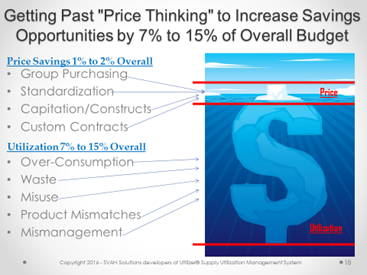The one thing we find that is holding back hospital supply chain/value analysis practitioners from receiving the full savings and quality benefits of clinical supply utilization management is “price thinking.” Too often, the first thought that comes into a value analysis team member’s mind when they evaluate a new or existing product, service, or technology is, “What is its cost and can we standardize on this product, service, or technology?” instead of thinking about the total lifecycle cost of this new or current product, service, or technology.
Clinical Supply Utilization Management
To bring this point home, in figure 1 we illustrate that our surveys have shown at most hospitals, systems, or IDNs, the most you can save is 1% to 3% more in price savings, from all sources. Whereas, with clinical supply utilization management you can save 7% to 15% of your supply chain expense budget. These numbers are hard to believe for some healthcare supply chain and value analysis professionals, but they are true and accurate; clinical supply utilization management is where your big savings reside.
Figure 1

Complete This Quiz for Validation
Please provide the answer to this critical question: My price savings is (a) shrinking right before my eyes, (b) just a trickle of what it once was, (c) about the same as it used to be or (d) more savings than it used to be. If your answer is c or d, you can ignore this utilization topic for a few years, although we wouldn’t recommend you do so. However, if your answer is a or b (like most hospitals, systems, and IDNs) then you need to remove price thinking from your value analysis equation and replace it with total lifecycle cost thinking.
Smallest Element of Lifecyle Cost is Price
Even though we all worry about attaining the best price at the pump, we should be equally concerned about the total lifecycle cost of the products, services, and technologies we are buying, since price is the smallest element of our total lifecycle cost. The running cost or in-use cost is where most of our supply budgets are consumed. So, let’s make sure to have the lowest in-use or utilization cost before we get fixated on the price of the commodities we are buying.
Note: This blog post is an excerpt from the e-booklet “A Strategic Approach to Integrating Clinical Utilization Management Into Your Value Analysis Program.” If you would like a copy of this e-booklet, please e-mail us at [email protected].
Below are some similar articles that you may find interesting.
9 Things to Negotiate with Your Purchased Service Contracts Other Than Price
Beyond The Data: New Thinking About Healthcare Supply Chain Success
